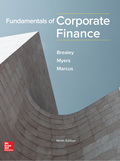
EBK FUNDAMENTALS OF CORPORATE FINANCE
9th Edition
ISBN: 9781260049237
Author: BREALEY
Publisher: MCGRAW HILL BOOK COMPANY
expand_more
expand_more
format_list_bulleted
Concept explainers
Question
Chapter 6, Problem 17QP
a)
Summary Introduction
To determine: The price of the bond.
b)
Summary Introduction
To determine: The
c)
Summary Introduction
To determine: The bond’s rate of return if the rate of interest is paid semi-annually.
d)
Summary Introduction
To determine: The real rate of return of the bond.
Expert Solution & Answer
Want to see the full answer?
Check out a sample textbook solution
Students have asked these similar questions
Could you help explain “How an exploratory case study could be goodness of work that is pleasing to the Lord?”
What are the case study types and could you help explain and make an applicable example.What are the 4 primary case study designs/structures (formats)?
The Fortune Company is considering a new investment. Financial projections for the investment are tabulated below. The corporate tax rate is 24 percent. Assume all sales revenue is received in cash, all operating costs and income taxes are paid in cash, and all cash flows occur at the end of the year. All net working capital is recovered at the end of the project.
Year 0
Year 1
Year 2
Year 3
Year 4
Investment
$ 28,000
Sales revenue
$ 14,500
$ 15,000
$ 15,500
$ 12,500
Operating costs
3,100
3,200
3,300
2,500
Depreciation
7,000
7,000
7,000
7,000
Net working capital spending
340
390
440
340
?
Chapter 6 Solutions
EBK FUNDAMENTALS OF CORPORATE FINANCE
Ch. 6 - Prob. 1QPCh. 6 - Bond Yields. A 30-year Treasury bond is issued...Ch. 6 - Prob. 3QPCh. 6 - Bond Yields. A bond with face value $1,000 has a...Ch. 6 - Bond Pricing. A General Power bond carries a...Ch. 6 - Prob. 6QPCh. 6 - Prob. 7QPCh. 6 - Prob. 8QPCh. 6 - Prob. 9QPCh. 6 - Prob. 10QP
Ch. 6 - Prob. 11QPCh. 6 - Prob. 12QPCh. 6 - Pricing Consol Bonds. Perpetual Life Corp. has...Ch. 6 - Bond Pricing. Sure Tea Co. has issued 9% annual...Ch. 6 - Prob. 15QPCh. 6 - Prob. 16QPCh. 6 - Prob. 17QPCh. 6 - Prob. 18QPCh. 6 - Prob. 19QPCh. 6 - Rate of Return. A 2-year-maturity bond with face...Ch. 6 - Prob. 21QPCh. 6 - Prob. 22QPCh. 6 - Prob. 23QPCh. 6 - Prob. 24QPCh. 6 - Interest Rate Risk. Consider two bonds, a 3-year...Ch. 6 - Interest Rate Risk. Suppose interest rates...Ch. 6 - Interest Rate Risk. Look again at the previous...Ch. 6 - Interest Rate Risk. Consider two 30-year-maturity...Ch. 6 - The Yield Curve. Suppose that investors expect...Ch. 6 - Yield Curve. The following table shows the prices...Ch. 6 - Yield Curve. In Figure 6.7, we saw a plot of the...Ch. 6 - Credit Risk.
Many years ago, Castles in the Sand...Ch. 6 - Credit Risk. Suppose that Casino Royale has issued...Ch. 6 - Credit Risk. Bond A is a 10-year U.S. Treasury...Ch. 6 - Prob. 35QPCh. 6 - Credit Risk. Sludge Corporation has two bonds...Ch. 6 - Prob. 37QP
Knowledge Booster
Learn more about
Need a deep-dive on the concept behind this application? Look no further. Learn more about this topic, finance and related others by exploring similar questions and additional content below.Similar questions
- What are the six types of alternative case study compositional structures (formats)used for research purposes, such as: 1. Linear-Analytical, 2. Comparative, 3. Chronological, 4. Theory Building, 5. Suspense and 6. Unsequenced. Please explainarrow_forwardFor an operating lease, substantially all the risks and rewards of ownership remain with the _________. QuestFor an operating lease, substantially all the risks and rewards of ownership remain with the _________: A) Tenant b) Lessee lessor none of the above tenant lessee lessor none of the aboveLeasing allows the _________ to acquire the use of a needed asset without having to make the large up-front payment that purchase agreements require Question 4 options: lessor lessee landlord none of the abovearrow_forwardHow has AirBnb negatively affected the US and global economy? How has Airbnb negatively affected the real estate market? How has Airbnb negatively affected homeowners and renters market? What happened to Airbnb in the Tax Dispute in Italy?arrow_forward
- How has AirBnb positively affected the US and global economy? How has Airbnb positively affected the real estate market? How has Airbnb positively affected homeowners and renters market?arrow_forwardD. (1) Consider the following cash inflows of a financial product. Given that the market interest rate is 12%, what price would you pay for these cash flows? Year 0 1 2 3 4 Cash Flow 160 170 180 230arrow_forwardExplain why financial institutions generally engage in foreign exchange tradingactivities. Provide specific purposes or motivations behind such activities.arrow_forward
- A. In 2008, during the global financial crisis, Lehman Brothers, one of the largest investment banks, collapsed and defaulted on its corporate bonds, causing significant losses for bondholders. This event highlighted several risks that investors in corporate bonds might face. What are the key risks an investor would encounter when investing in corporate bonds? Explain these risks with examples or academic references. [15 Marks]arrow_forwardTwo companies, Blue Plc and Yellow Plc, have bonds yielding 4% and 5.3%respectively. Blue Plc has a credit rating of AA, while Yellow Plc holds a BB rating. If youwere a risk-averse investor, which bond would you choose? Explain your reasoning withacademic references.arrow_forwardB. Using the probabilities and returns listed below, calculate the expected return and standard deviation for Sparrow Plc and Hawk Plc, then justify which company a risk- averse investor might choose. Firm Sparrow Plc Hawk Plc Outcome Probability Return 1 50% 8% 2 50% 22% 1 30% 15% 2 70% 20%arrow_forward
arrow_back_ios
SEE MORE QUESTIONS
arrow_forward_ios
Recommended textbooks for you
 Intermediate Financial Management (MindTap Course...FinanceISBN:9781337395083Author:Eugene F. Brigham, Phillip R. DavesPublisher:Cengage Learning
Intermediate Financial Management (MindTap Course...FinanceISBN:9781337395083Author:Eugene F. Brigham, Phillip R. DavesPublisher:Cengage Learning

Intermediate Financial Management (MindTap Course...
Finance
ISBN:9781337395083
Author:Eugene F. Brigham, Phillip R. Daves
Publisher:Cengage Learning
Bond Valuation - A Quick Review; Author: Pat Obi;https://www.youtube.com/watch?v=xDWTPmqcWW4;License: Standard Youtube License